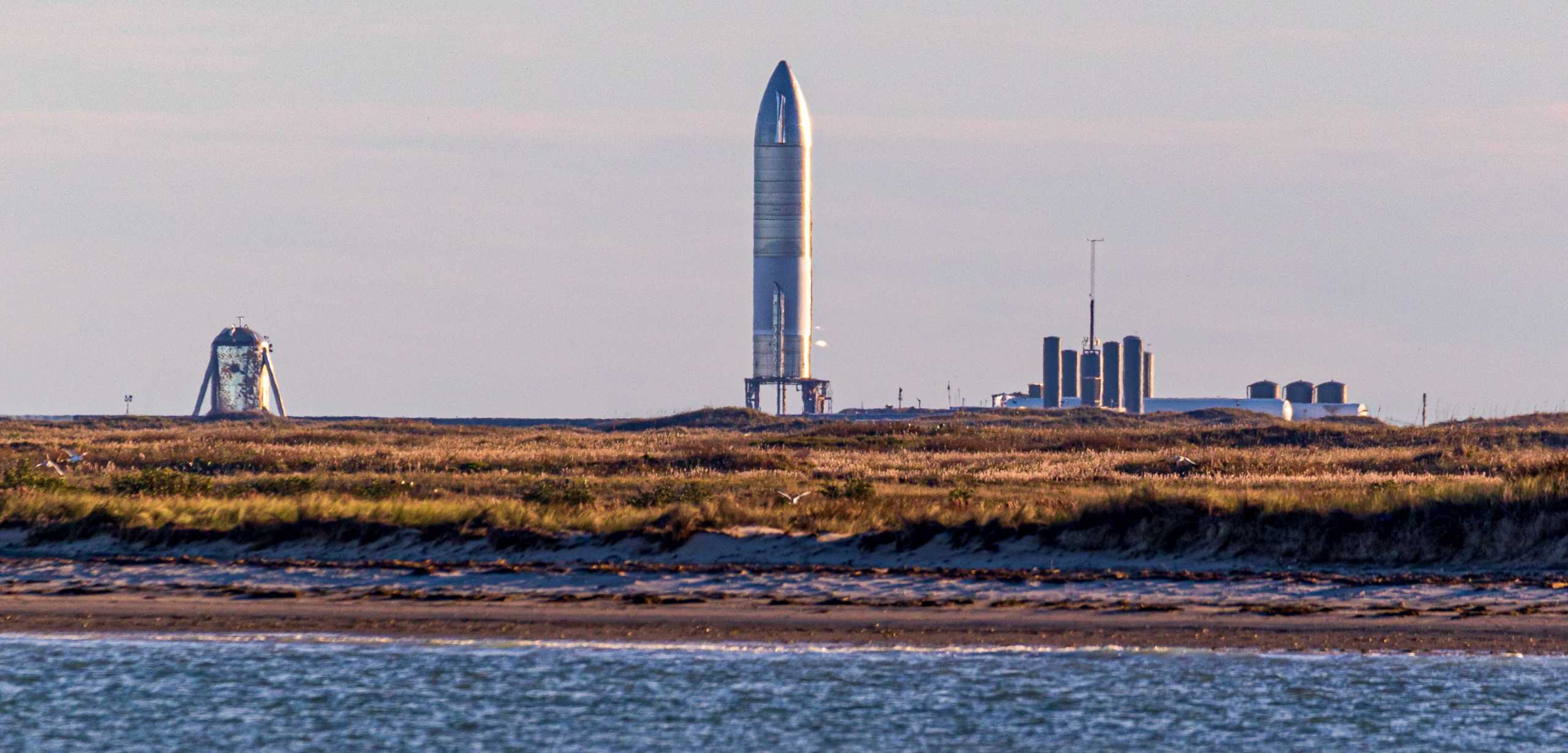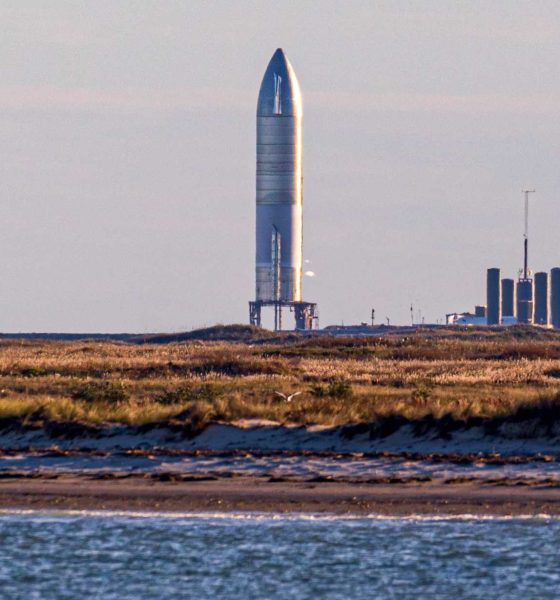

News
SpaceX high-altitude Starship debut go for a second launch attempt
Update (Dec 9th): All signs point to a second attempt at SpaceX’s high-altitude Starship launch debut sometime near the end of today’s window, likely no earlier than 3:30-4 pm CST (UTC-6).
Amazingly, the actual pilot of the NASA WB-57 reconnaissance aircraft tasked with capturing aerial photos and videos of Starship SN8’s first flight is on Twitter and confirmed that the aircraft had been just a few minutes from takeoff before SpaceX chose to delay the launch for a few more hours. Thankfully, as of 2 pm CST, ground equipment activity at the pad is rapidly picking up – a good sign that SN8 launch preparations are well underway.

Stay tuned for SpaceX’s official Starship SN8 launch livestream around five minutes before liftoff and tune into NASASpaceflight.com’s excellent coverage below to keep up to date on launch proceedings.
Update: Starship serial number 8 (SN8) aborted its high-altitude launch debut at the last second, ending today’s attempt for SpaceX.
Depending on why one or several of the steel rocket’s three advanced Raptor engines aborted their ignition, SpaceX has backup launch windows and airspace closures from 8am to 5pm CST (UTC-6) on December 9th and 10th. Stay tuned for updates on the cause of the abort and whether Starship SN8 can be prepared for another attempt less than a day from now.
In a last-minute surprise, SpaceX appears to have secured NASA support for Starship SN8’s first flight in the form of a space agency reconnaissance jet often used to capture aerial photos and videos of spaceflight events.
Primarily intended to capture those views for developmental, data-gathering purposes, NASA WB-57 jets have recently been used to milestones like SpaceX’s explosive Crew Dragon In-Flight Abort test and Demo-2 astronaut launch/reentry debut. Likely made possible by a $135 million Starship Moon lander development contract awarded by NASA in April, the space agency has positioned itself to benefit from SpaceX’s success and leverage the company’s extensive internal investments.
Aside from exemplifying NASA’s new and promising relationship with SpaceX’s Starship development program, the use of space agency surveillance assets also serves as a convenient barometer to judge Starship SN8’s launch timing with.

As of publishing (1:30 pm EST, UTC-5), NASA’s WB-57 jet is scheduled to take off from Houston’s Ellington Airport at 2:12 pm CST, arriving ‘on station’ in the vicinity of SpaceX’s Boca Chica, Texas launch pad around 3:10 pm. With NASA assets now in play, Starship SN8 is unlikely to lift off before the jet is in place, meaning that the rocket’s 12.5 km (~7.8 mi) launch debut is now scheduled sometime between ~3:15 pm and 5 pm CST (UTC-6).
SpaceX CEO Elon Musk recently reiterated his prediction that Starship SN8 has a ~33% chance of successfully launching, reaching an apogee of ~12.5 km, free-falling belly-first most of the way back to earth, performing a radical flip maneuver, and landing intact. With Starship SN9 – effectively a refined clone of SN8 – practically complete and ready to roll to the launch pad, SpaceX’s hardware-rich development program means that almost any SN8 outcome at all will produce valuable data.
For a program like Starship, the success of any early prototype is better judged on the quantity and quality of data gathered and lessons learned than on the survival of hardware. Even so, SpaceX is clearly working to give Starship SN8 the best possible shot at survival and a successful landing would be a truly spectacular outcome. Stay tuned for updates as we track towards SN8’s first flight!

Elon Musk
Starlink passes 9 million active customers just weeks after hitting 8 million
The milestone highlights the accelerating growth of Starlink, which has now been adding over 20,000 new users per day.

SpaceX’s Starlink satellite internet service has continued its rapid global expansion, surpassing 9 million active customers just weeks after crossing the 8 million mark.
The milestone highlights the accelerating growth of Starlink, which has now been adding over 20,000 new users per day.
9 million customers
In a post on X, SpaceX stated that Starlink now serves over 9 million active users across 155 countries, territories, and markets. The company reached 8 million customers in early November, meaning it added roughly 1 million subscribers in under seven weeks, or about 21,275 new users on average per day.
“Starlink is connecting more than 9M active customers with high-speed internet across 155 countries, territories, and many other markets,” Starlink wrote in a post on its official X account. SpaceX President Gwynne Shotwell also celebrated the milestone on X. “A huge thank you to all of our customers and congrats to the Starlink team for such an incredible product,” she wrote.
That growth rate reflects both rising demand for broadband in underserved regions and Starlink’s expanding satellite constellation, which now includes more than 9,000 low-Earth-orbit satellites designed to deliver high-speed, low-latency internet worldwide.
Starlink’s momentum
Starlink’s momentum has been building up. SpaceX reported 4.6 million Starlink customers in December 2024, followed by 7 million by August 2025, and 8 million customers in November. Independent data also suggests Starlink usage is rising sharply, with Cloudflare reporting that global web traffic from Starlink users more than doubled in 2025, as noted in an Insider report.
Starlink’s momentum is increasingly tied to SpaceX’s broader financial outlook. Elon Musk has said the satellite network is “by far” the company’s largest revenue driver, and reports suggest SpaceX may be positioning itself for an initial public offering as soon as next year, with valuations estimated as high as $1.5 trillion. Musk has also suggested in the past that Starlink could have its own IPO in the future.
News
NVIDIA Director of Robotics: Tesla FSD v14 is the first AI to pass the “Physical Turing Test”
After testing FSD v14, Fan stated that his experience with FSD felt magical at first, but it soon started to feel like a routine.

NVIDIA Director of Robotics Jim Fan has praised Tesla’s Full Self-Driving (Supervised) v14 as the first AI to pass what he described as a “Physical Turing Test.”
After testing FSD v14, Fan stated that his experience with FSD felt magical at first, but it soon started to feel like a routine. And just like smartphones today, removing it now would “actively hurt.”
Jim Fan’s hands-on FSD v14 impressions
Fan, a leading researcher in embodied AI who is currently solving Physical AI at NVIDIA and spearheading the company’s Project GR00T initiative, noted that he actually was late to the Tesla game. He was, however, one of the first to try out FSD v14.
“I was very late to own a Tesla but among the earliest to try out FSD v14. It’s perhaps the first time I experience an AI that passes the Physical Turing Test: after a long day at work, you press a button, lay back, and couldn’t tell if a neural net or a human drove you home,” Fan wrote in a post on X.
Fan added: “Despite knowing exactly how robot learning works, I still find it magical watching the steering wheel turn by itself. First it feels surreal, next it becomes routine. Then, like the smartphone, taking it away actively hurts. This is how humanity gets rewired and glued to god-like technologies.”
The Physical Turing Test
The original Turing Test was conceived by Alan Turing in 1950, and it was aimed at determining if a machine could exhibit behavior that is equivalent to or indistinguishable from a human. By focusing on text-based conversations, the original Turing Test set a high bar for natural language processing and machine learning.
This test has been passed by today’s large language models. However, the capability to converse in a humanlike manner is a completely different challenge from performing real-world problem-solving or physical interactions. Thus, Fan introduced the Physical Turing Test, which challenges AI systems to demonstrate intelligence through physical actions.
Based on Fan’s comments, Tesla has demonstrated these intelligent physical actions with FSD v14. Elon Musk agreed with the NVIDIA executive, stating in a post on X that with FSD v14, “you can sense the sentience maturing.” Musk also praised Tesla AI, calling it the best “real-world AI” today.
News
Tesla AI team burns the Christmas midnight oil by releasing FSD v14.2.2.1
The update was released just a day after FSD v14.2.2 started rolling out to customers.

Tesla is burning the midnight oil this Christmas, with the Tesla AI team quietly rolling out Full Self-Driving (Supervised) v14.2.2.1 just a day after FSD v14.2.2 started rolling out to customers.
Tesla owner shares insights on FSD v14.2.2.1
Longtime Tesla owner and FSD tester @BLKMDL3 shared some insights following several drives with FSD v14.2.2.1 in rainy Los Angeles conditions with standing water and faded lane lines. He reported zero steering hesitation or stutter, confident lane changes, and maneuvers executed with precision that evoked the performance of Tesla’s driverless Robotaxis in Austin.
Parking performance impressed, with most spots nailed perfectly, including tight, sharp turns, in single attempts without shaky steering. One minor offset happened only due to another vehicle that was parked over the line, which FSD accommodated by a few extra inches. In rain that typically erases road markings, FSD visualized lanes and turn lines better than humans, positioning itself flawlessly when entering new streets as well.
“Took it up a dark, wet, and twisty canyon road up and down the hill tonight and it went very well as to be expected. Stayed centered in the lane, kept speed well and gives a confidence inspiring steering feel where it handles these curvy roads better than the majority of human drivers,” the Tesla owner wrote in a post on X.
Tesla’s FSD v14.2.2 update
Just a day before FSD v14.2.2.1’s release, Tesla rolled out FSD v14.2.2, which was focused on smoother real-world performance, better obstacle awareness, and precise end-of-trip routing. According to the update’s release notes, FSD v14.2.2 upgrades the vision encoder neural network with higher resolution features, enhancing detection of emergency vehicles, road obstacles, and human gestures.
New Arrival Options also allowed users to select preferred drop-off styles, such as Parking Lot, Street, Driveway, Parking Garage, or Curbside, with the navigation pin automatically adjusting to the ideal spot. Other refinements include pulling over for emergency vehicles, real-time vision-based detours for blocked roads, improved gate and debris handling, and Speed Profiles for customized driving styles.








